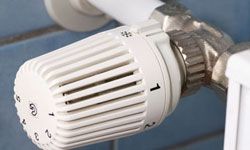 “Get some simple tips to lower your heating bills.iStockphoto/Thinkstock
“Get some simple tips to lower your heating bills.iStockphoto/Thinkstock “Turn your heating down before bedtime saves energy, and once you’re tucked in you’ll never notice the difference. Get more tips at FutureFriendly.comP&G
“Turn your heating down before bedtime saves energy, and once you’re tucked in you’ll never notice the difference. Get more tips at FutureFriendly.comP&G
Every year we hear the bad news: Home heating costs are on the rise again, and we should brace ourselves — winter is on the way. We’ve collected five easy tips homeowners and renters can use to lower their heating bills this winter, without calling in a professional or breaking the bank.
Contents
- Be Smart About Ceiling Fans
- Keep a Damper On It
- Draw the Curtains
- Water Works
- Adjust the Thermostat
5. Be Smart About Ceiling Fans
In warm weather you want your ceiling fans to operate counterclockwise, pushing air in downward to provide a steady cool breeze. During the winter, you can have this same fan work for you, too.
By reversing the fan’s direction and keeping it at a low speed in a clockwise direction, the blades will create an updraft, taking full advantage of the fact heat rises. This reverse air circulation helps to move hot air downward toward your living space and eliminate hot and cold spots.
4. Keep a Damper On It
In elementary-school science class, we learned that warm air rises. As a homeowner or renter, keep that tidbit of knowledge in your pocket and make sure that same warm air doesn’t escape from your home – right out of your chimney.
The U.S. Department of Energy reports that while you’re getting cozy in front of a fire, your fireplace is allowing as much as 24,000 cubic feet of warm air from inside your home to escape outside. At the same time, cold air from the outside floods in.
A few simple tricks will help you avoid this. First, do you actually use your fireplace? If you answer "never," seal the chimney flue for the best stopper against heat loss.
If you do use your fireplace, be sure to keep the damper closed whenever you don’t have a fire going — an open damper is like an open window. And check the damper seal to ensure it’s tight.
Did You Know?
When using your fireplace, the Department of Energy suggests cracking open the nearest window, closing doors that lead into the room where your fire is going, and lowering the thermostat to about 55 degrees Fahrenheit.
3. Draw the Curtains
In addition to weather stripping and sealing leaks around your windows, your choice of window treatments can make a big difference in your home heating costs.
Insulated curtains save energy by helping to reduce drafts and heat loss (another bonus of insulated curtains is they also help block sound), but the benefits will depend on the type of curtains you hang — look for ones that include at least acrylic or high-density foam insulation and reflective film that helps direct heat into the room.
Once you have them hung, use them wisely. Take advantage of solar heat — keep curtains open during the day to help raise the indoor temperature and close them at night to help the room retain heat.
Tip: Another benefit of having insulated curtains in your home? They help block noise from outside.
2. Water Works
Many water heater thermostat manufacturers ship products that are preset at 140 degrees Fahrenheit, but most of us don’t need water that hot. In fact, 120 degrees Fahrenheit is sufficient for most households. As long as your shower is hot, will you notice the difference? Probably not — until your energy bills arrive. According to the U.S. Department of Energy, lowering your water temperature 10 degrees Fahrenheit will lower your energy costs by 3 to 5 percent.
Lowering the water temperature to 120 degrees Fahrenheit also helps your water heater run at its most efficient levels by keeping down corrosion and sediment build-up.
Tip: Dishwasher cleaning cycles should be run with 140 F degree water. If your dishwasher has a booster heater, lower your water heater thermostat without worry. If your dishwasher doesn’t have this feature, this tip may not be for you.
Did You Know?
Be aware of scalding risks: According to the U.S. Consumer Product Safety Commission, exposure to 140-degree Fahrenheit water can cause third-degree burns in just six seconds; 30 seconds in 130-degree Fahrenheit water.
1. Adjust the Thermostat
It seems easy enough, right? Lower your heating bill by turning down the heat.
We’re not suggesting you maintain an arctic climate inside your house. Simply keep your thermostat at about 68 degrees Fahrenheit during the day and if you’re cold, reach for a sweater. For each additional degree you lower the temperature (in the 60- to 70-degree Fahrenheit range) you continue to save cash — up to 5 percent on your heating bill.
Bonus savings: Install a smart thermostat that you can program to adjust the temperature while you’re away or while you sleep. The Environmental Protection Agency estimates you’ll save $180 on your annual energy bills this way.
Did You Know?
According to the EPA, the average American family spends more than $2,200 a year on home energy bills, with about 50 percent of that for heating and cooling.

































